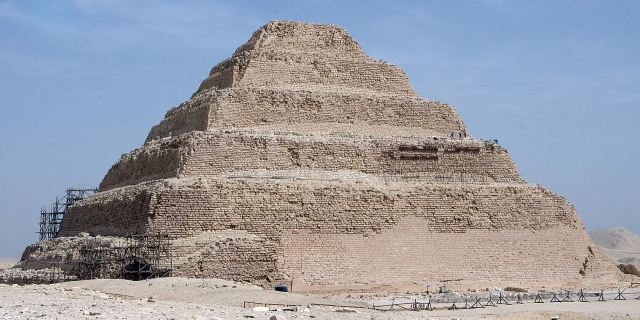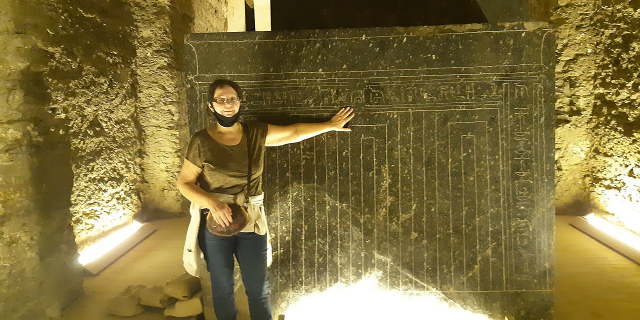دير الأنبا أنطونيوس (البحر الأحمر)
( Monastery of Saint Anthony )The Monastery of Saint Anthony is a Coptic Orthodox monastery standing in an oasis in the Eastern Desert of Egypt, in the northern part of the Red Sea Governorate close to the border with the Suez Governorate.
Hidden deep in the Red Sea Mountains, it is located 334 km (208 mi) southeast of Cairo and can be reached from Cairo in just 5 to 6 hours. The Monastery of Saint Anthony was established by the followers of Anthony the Great, an early Christian monk. The monastery is one of the most prominent in Egypt and has strongly influenced the formation of several Coptic institutions, and has promoted monasticism in general. Several patriarchs have come from the monastery, and several hundred pilgrims visit it each day.
In 2002, the Egyptian government began what was to be an 8-year, $14.5 million project to restore the monastery. The modern monastery is a self-contained village with gardens, a mill, a bakery and five churches. It has become a popular destination for ...Read more
The Monastery of Saint Anthony is a Coptic Orthodox monastery standing in an oasis in the Eastern Desert of Egypt, in the northern part of the Red Sea Governorate close to the border with the Suez Governorate.
Hidden deep in the Red Sea Mountains, it is located 334 km (208 mi) southeast of Cairo and can be reached from Cairo in just 5 to 6 hours. The Monastery of Saint Anthony was established by the followers of Anthony the Great, an early Christian monk. The monastery is one of the most prominent in Egypt and has strongly influenced the formation of several Coptic institutions, and has promoted monasticism in general. Several patriarchs have come from the monastery, and several hundred pilgrims visit it each day.
In 2002, the Egyptian government began what was to be an 8-year, $14.5 million project to restore the monastery. The modern monastery is a self-contained village with gardens, a mill, a bakery and five churches. It has become a popular destination for Egyptians, offering Egyptian Christians religious retreats as well as family excursions.
A few years after the death of Saint Anthony, his followers settled around the place where the hermit lived. The Monastery of Saint Anthony was built between 298 and 300 during the reign of Constantius Chlorus.[1] In the original settlement, his followers established only the most essential buildings. Isolation was stressed. They lived in solitary cells surrounding a communal worship center where they performed the Divine Liturgy. They took their daily meals in a basic refectory.[2] As time passed, the focus on asceticism diminished, and St. Anthony's followers began to develop closer relationships with one another in order to foster safety, convenience, and mutual fellowship.[2] The life of an Antonian monk thus slowly evolved from one of solitary asceticism to one that allowed a communal way of living.
The Monastery as a refuge (400–800)In the sixth and seventh centuries, many monks from the monasteries of Scetes fled to the Monastery of Saint Anthony in order to escape frequent attack by Bedouins and Berbers. During this time, the monastery experienced a constantly shifting and sometimes mutual occupation by the Coptic monks from Scetes and by the Melkite monks from the east. In 615, John the Merciful, the Melkite Patriarch, sent Anastasius of Persia, the head of the Monastery of St. Anthony at that time, large sums of money and asked him to take some Melkite monks who were persecuted by the Persians.[3] These Melkite monks then continued to oversee the monastery until the late 8th century.
In 790 Coptic monks from the Monastery of Saint Macarius the Great in the Desert of Scetis disguised themselves as Bedouins in an attempt to steal the earthly remains of St. John the Short, who had lived and died in the Monastery of St. Anthony in the 5th century.[4] The Ethiopian Synaxarium describes how they deceived the Melkite monks to accomplish this task:
it was not possible for them to fulfill their mission for the moment, for the body of the saint was guarded by the Melkite Chalcedonians who dwelt in the sanctuary. Then the judge from among the Arabs said to the Melkite bishop who sat in the sanctuary: ‘make all your men get out of the church, for I wish to enter the church myself and stay here this night.’ The bishop did as the judge commanded, and the Coptic Monks made ready their beasts outside the town and entered by night and took the body and returned to the desert of Scetis. [5]
Peace and persecution (800–1300)Although the monastery of St. Anthony enjoyed relative peace and security in its remote area, there were short periods of intense persecution. The monastery itself was plundered a number of times by the Bedouins of the Eastern Desert, who partly destroyed it in the 11th century. There was also a rebellion by the Kurds and the Turks during this time. When their leader Nasir al-Dawla was defeated, the remains of his army invaded and pillaged the Monastery of St. Anthony as well as the nearby Monastery of Saint Paul the Anchorite.[6] The monastery was restored in the 12th century, and it flourished throughout the next few centuries. A fortress-like structure was also built around the monastery for protection from invaders. Abu al-Makarim describes the unparalleled excellence of the monastery in the beginning of the 13th century:
This monastery possesses many endowments and possessions at Misr. It is surrounded by a fortified wall. It contains many monks. Within the wall there is a large garden, containing fruitful palm trees, and apple trees, and pear trees, and pomegranates, and other trees besides beds of vegetables, and three springs of perpetually flowing water, with which the garden is irrigated and which the monks drink. One feddan and a sixth in the garden form a vineyard, which supplies all that is needed, and it is said that the number of the palms which the garden contains amounts to a thousand trees, and there stands in it a large well-built qasr… There is nothing like it among the other monasteries inhabited by Egyptian monks.[7]
Early European visitors (1300–1800)During the later crusades, European priests and diplomats began to tour Egypt as a part of their pilgrimage to the Holy Land. Ludolph of Suchem, a parish priest in the diocese of Paderborn, mentions his visits to the “many cells and hermitages of holy fathers,” many of which live under St. Anthony.[8] In his “Description of the Holy Land”, he describes the miraculous fountain of St. Anthony: “In this desert there is a place beneath an exceeding tall and narrow rock, wherein St. Anthony used to dwell, and from out of the rock there flows a stream for half a stone’s throw, until it is lost in the sand… this place is visited by many for devotions and pleasure, and also by the grace of God and in honor of St. Anthony many sicknesses are healed and driven away by the fountain.”[9]
In 1395, during the Crusade of Nicopolis, Ogier VIII d'Anglure journeyed to Egypt with several French pilgrims.[10] He compared the Monastery of St. Anthony to the Saint Catherine's Monastery, stating that it was even more beautiful and noted the holiness and charitable of the Jacobite monks.[10] By the early 15th century, the monastery had become an established pilgrimage destination and it was commonplace for pilgrims to inscribe their name, coat-of-arms, and date of arrival on the walls of the monastery.[10]
In the late 15th century, the monastery was devastated by the same Bedouins the monastery employed, and all of the monks were killed.[11] It then followed that Syrian monks began to occupy the monastery, and helped in the rebuilding of the monastery at the beginning of the 16th century.[12] After the restoration of the monastery, Ethiopian and Egyptian monks co-inhabited the monastery for some time. However, the monastery slowly fell completely into ruin and the few monks that lived there greatly relied on the support from the nearby village of Bush.[13] From then until the 19th century, there are various accounts of travelers who stopped by the monastery, but the monastery is only briefly mentioned in passing. It is known that Franciscan missionaries sometimes used the monastery as a base to prepare missionaries in the 17th century. However, the monastery was in such disarray that it lacked even a door, and travelers had to enter via a rope and basket operated with a pulley system.[14]
Modern history (from 1900)Before the dawn of the 20th century, the only way to get to the monastery was by way of the monthly camel caravans which brought in food and other necessities from the nearby village of Bush.[15] A journey along the desert path that extended from Kuraymat, a city along the Nile in between Beni Suef and Helwan, to the monastery used to take three to four days.[15] The monastery received very few visitors, but those who did come were often distinguished in status, such as Georges Cogordan, the French ambassador to Egypt in 1901, and Johann Georg, Duke of Saxony.[16]
The monastery became much more accessible after the opening of the Suez–Ras Gharib Road in 1946, and can now be reached from Cairo in just five to six hours.[17] During the first decade after construction, the number of foreigner visitors greatly increased, with about 370 visitors between 1953 and 1958.[17] Since then, the monastery has become a more popular destination for Egyptians, offering Egyptian Christians religious retreats as well as family excursions. Now on holiday weekends there are typically more than a thousand visitors.[17]

























Add new comment